- Meet Chacruna at Psychedelic Science 2025 - May 27, 2025
- Psychedelics and Attachment: Fundamentals, Implications, and New Frontiers - May 16, 2025
- Development Outreach Internship (OPEN) - May 6, 2025
In 2017 Chacruna was invited to make a selection of ‘state of the art’ social science references on ayahuasca and other plant medicines. We thought that we would share it here. Notwithstanding, any selection is inherently narrow and limited. With this in mind, the following are some of our favorites:
BEYER, S. 2009. Singing to the Plants: A Guide to Mestizo Shamanism in the Upper Amazon. Albuquerque: University of New Mexico Press.

In the Upper Amazon, mestizos are the Spanish-speaking descendants of Hispanic colonizers and the indigenous peoples of the jungle. Some mestizos have migrated to Amazon towns and cities, such as Iquitos and Pucallpa; most remain in small villages. They have retained features of a folk Catholicism and traditional Hispanic medicine, and have incorporated much of the religious tradition of the Amazon, especially its healing, sorcery, shamanism, and the use of potent plant hallucinogens, including ayahuasca. The result is a uniquely eclectic shamanist culture that continues to fascinate outsiders with its brilliant visionary art. Ayahuasca shamanism is now part of global culture. Once the terrain of anthropologists, it is now the subject of novels and spiritual memoirs, while ayahuasca shamans perform their healing rituals in Ontario and Wisconsin.
Singing to the Plants sets forth just what this shamanism is about–what happens at an ayahuasca healing ceremony, how the apprentice shaman forms a spiritual relationship with the healing plant spirits, how sorcerers inflict the harm that the shaman heals, and the ways that plants are used in healing, love magic, and sorcery.
BROWMAN, D. & SCHWARZ, R. (eds). 1979. Spirits, Shamans, and Stars: Perspectives from South America. The Hague: Mouton Publishers.
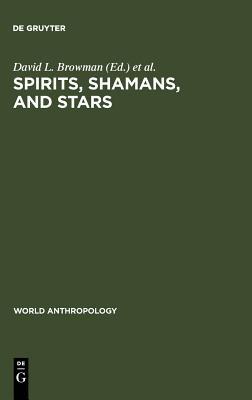
Spirits, Shamans and Stars: Perspectives from South America, originally published in 1979, is a collection based on papers presented in the International Congress of Anthropological and Ethnological Sciences held in 1973. The book portrays anthropological research emerging in the 1960s that was focusing on symbolic and medical anthropology, and it includes interrelated themes ranging from studies of shamanic practices, pychotropic drugs to indigenous and popular therapeutic practices throughout South America. At the time of the Congress, studies in shamanic systems were undergoing an innovative renewal with focus on the relation between ritual practices and the construction of cosmologies and social bodies. Not only does the book examine the use of specific substances, such as tobacco, coca, cannabis and ayahuasca, but various articles focus on ethnographic contexts and the dynamics of ritual processes that construct and transform spiritual, social and individual bodies. A number of chapters are by young scholars beginning their careers whose contributions are considered today as classics in shamanism and therapeutic practices. Among these we can site Miguel Bartolomé on the Avá-Chiripá; Ken Taylor on the Yanomami; Jean-Paul Dumont on the Panare; Douglas Sharon on Peruvian curanderos; and E. Jean Langdon on the Siona. Others authors are more seasoned scholars, and among these there is an important contribution by Latin American psychiatrists interested in non-western mental health and healing. In reference to this last topic, one of the co-authors, Jaisie Naidoo, was a former plantation worker and indigenous healer from Guyana collaborating with students and researchers of indigenous healing at the Oakland University, Michigan. (summary by E. Jean Langdon)
BURROUGHS, W. & GINSBERG, A. 2006 (1963). The Yage Letters: Redux. Edited and with an Introduction by Oliver C.G Harris. San Francisco: City Lights Books.
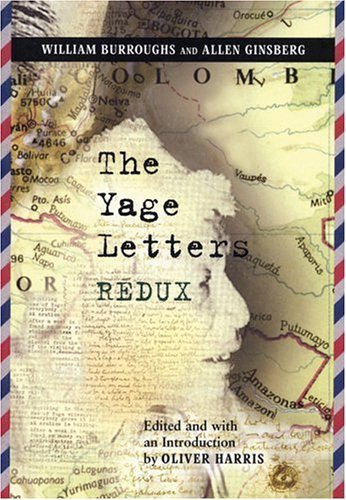
In January 1953, William S. Burroughs began an expedition into the jungles of South America to find “yage,” the fabled hallucinogen of the Amazon. From the notebooks he kept and the letters he wrote home to Allen Ginsberg, Burroughs composed a narrative of his adventures that later appeared as “The Yage Letters.” For this edition, Oliver Harris has gone back to the original manuscripts and untangled the history of the text, telling the fascinating story of its genesis and cultural importance. Also included in this edition are extensive materials, never before published, by both Burroughs and Ginsberg.William S. Burroughs is widely recognized as one of the most influential and innovative writers of the twentieth century. His books include “Junky,” “Naked Lunch,” and “The Wild Boys.”
CALVO, C. 1995. Three Halves of Ino Moxo: Teachings of the Wizard of the Upper Amazon. Rochester: Inner Traditions.

Award-winning Peruvian author Cesar Calvo takes us on a quest through the mysterious, dreamlike world of powerful Amazonian sorcerers.
CARDENAS, C. 1989. Los Unaya y su Mundo. Aproximacion al Sistema Medico de los Shipibo-Conibo del Rio Ucayali. Lima: Instituto Indigenista Peruano/ CAAAP.

“… the medicine of the shipibo-conibo survives and is used; Has its own space alongside modern medicine and popular medicine. “But the Shipibo-conibo people, in extreme cases, do not entrust their health to their Unayas alone, pragmatically alternating their treatment between them and the official medical services, To the results and their economic capacity.
CHAUMEIL, J. 1999. Ver, Saber, Poder: Chamanismo de los Yagua de la Amazonía Peruana. Lima: Centro Amazonico de Antropologia y Aplicacion Practica.

This work proposes an anthropological approach to shamanism in which this phenomenon regains its full expression as a social institution within the framework of a South American case study, that of the Yagua of the Peruvian Amazon. The study of shamanism appears, on the other hand, necessary to understand the dynamics of social identities and the new forms of interethnic relations in the northern Amazonian region of Peru. Far from being a mere legacy of the past, the shamanic institution presents itself as a current phenomenon, whose dynamism must be taken into account both by local policy makers and by the promoters of programs to support indigenous communities Peruvian.
DESCOLA, P. 1986. La Nature Domestique: Symbolisme et Praxis dans L’écologie des Achuar. Paris: Édition de la Maison des Sciences de l’Homme.
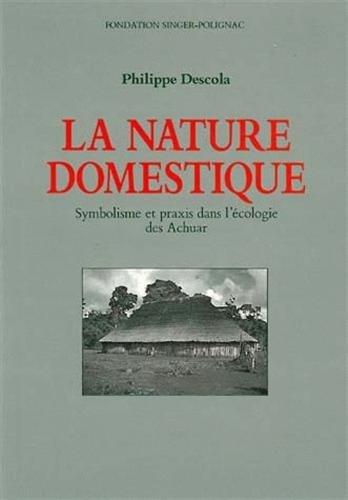
The Ecuadorian Amazonian Jivaro Achuar domesticate in the imagination a wild world that they have little transformed. By populating the jungle, the rivers and the gardens of animal and vegetable parents to be seduced, forced or cajoled, this warrior ethnic group gives nature all the appearances of society. From a detailed ethnography of domestic economy, the author shows that this symbolic ecology is not reducible to an illusory reflection of reality because it influences the technical choices of the Achuar and, no doubt, even their becoming historical.
DESCOLA, P. 1993. Les Lances du Crépuscule. Relations Jivaros, Haute-Amazonie. Paris: Terre Humaine.
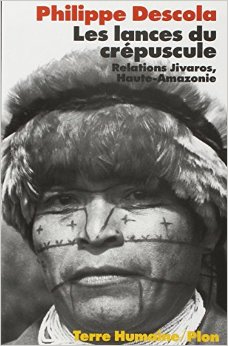
They are called Jivaros. They prefer to denominate Achuar, the people of the water palm. Isolated in the jungle of high Amazonia, this legendary tribe was protected during centuries of the incursion of Whites by its worrying reputation of headhunters. More than a condition of their independence, war is for these Indians a cardinal virtue; It gives prestige, strengthens solidarity, strengthens ethnic identity and allows the ritual renewal of souls. Thanks to her, the Achuar are still several thousand, proud of their traditions and fiercely attached to their way of life.
This book is a chronicle of their discovery and a tribute to their resistance. Philippe Descola tells the everyday story of the stages of increasing emotional and intellectual intimacy with the people he shared for nearly three years as an anthropologist.
This exceptional testimony about a free and almost forgotten way of living the human condition draws from a singular experience a teaching for the present time.
DOBKIN DE RIOS, M. 1972. Visionary Vine: Psychedelic Healing in the Peruvian Amazon. San Francisco: Chandler Publishing Co.
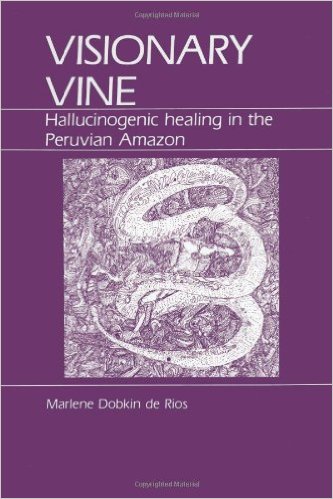
The area of traditional folk healing with plant hallucinogens, such as the Peruvian urban setting studied here, is a unique human laboratory that is of interest to medical anthropologists, biologists, psychologists, and students of anthropology in general. One of the earliest firsthand observations of a practicing shaman and his use of native herbal medicines and psychedelic pharmaceuticals, this text makes an important contribution to understanding culture, illness, and healing.
ERIKSON, P. 2004. Paraíso Abierto, Jardines Cerrados: Pueblos Indígenas y Biodiversidad. Quito: Abya-Yala.
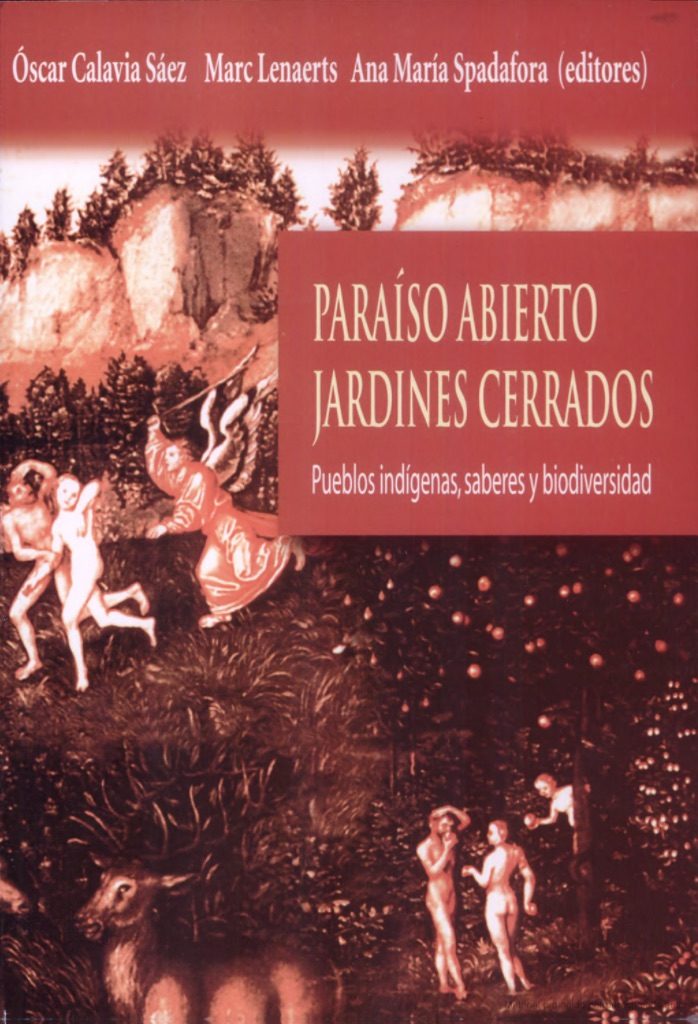
Nos ocuparemos en este libro de las distintas combinaciones de conceptos que pueden extraerse de ese título de sabor barroco. La obra es resultado de una serie de investigaciones e intercambios entre investigadores de países de América Latina y Europa. Los primeros en el tiempo, y los de más larga duración, se deben a un proyecto financiado por la Comunidad Europea denominado Transmission et Transformation des Savoirs sur l ́Environnement en Milieu Indigène et Métis (de aquí en adelante, TSEMIM), que ya se ha plasmado en diversas publicaciones y en dos eventos realizados en el Brasil: el Encuentro Saberes Indígenas: Cosmología, Ecología y Política, que tuvo lugar en noviembre de 2000 en la Isla de Santa Catarina, y el Simposio Bio Industrias, Sabres y Derechos Locales, realizado en noviembre de 2001 en la ciudad de Curitiba. Las páginas que siguen exponen los frutos de toda esa actividad, pero también reflexiones sobre su desarrollo, las respuestas y las dudas que suscitó. El temario es amplio: va desde la mitología, las taxonomías indígenas y la farmacopea curativa o erótica, hasta la tensión entre exoterismo y esoterismo, que se observa en determinadas prácticas chamánicas; desde la política, que rige la transmisión de saberes dentro de la aldea, hasta el destino que aguarda a esos mismos saberes en una situación de creciente dependencia y economía globalizada.
GHASARIAN, C. & BAUD, S. 2010. Des Plantes Psychotropes: Initiations, Thérapies et Quetes de Soi. Paris: Editions Imago.

Ayahuasca, San Pedro, iboga, Absinthe … all these psychotropic plants are consumed in many societies, “there” or “here”, in South America, in Africa, and in the heart Even from Europe where workshops are organized for people looking for new spiritualities.
The authors of this work, recognized international specialists – anthropologists, but also ethnopharmacologists, philosophers, psychologists, doctors … – analyze the motivations of the adepts, the circumstances in which these practices take place, as well as the somatic and psychic effects caused by the catch . They observe that these age-old uses can be found in several settings: initiations specific to ancient and contemporary shamanic cultures, therapies including experiments with addicts and, finally, spiritual quests, through a Western reappropriation in New Age logic.
Without censorship or taboo, with rigor and a constant concern for objectivity, the researchers gathered in this book offer us, at the crossroads of several disciplines, original reflections on a sensitive and controversial subject.
GIOVE, R. 2016. Ritual del Ayahuasca: Patrimonio Cultural de la Nación. Moyobamba: Dirección desconcentrada de cultura San Martín,
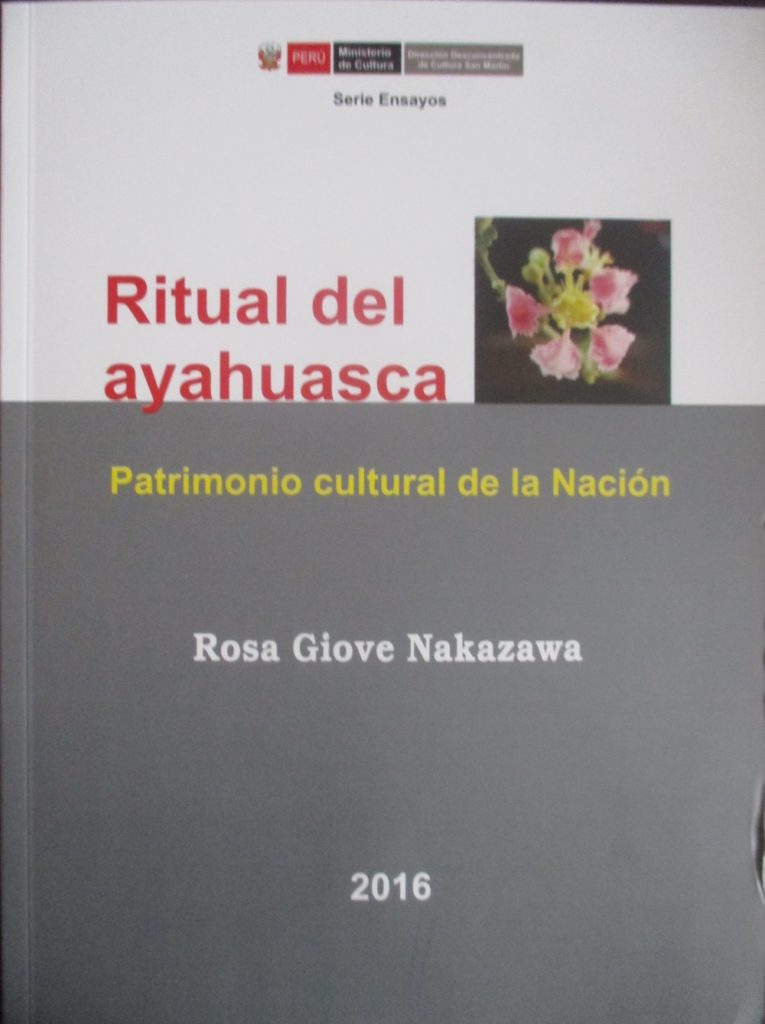
Se publica el documento elaborado como parte del proceso de rescate y protección de saberes y recursos tradicionales emblemáticos en la región San Martín y el Perú, y que resultó en la declaración como Patrimonio Cultural de la Nación a los Conocimientos y Usos Tradicionales del Ayahuasca practicados por comunidades nativas amazónicas, que fue emitida por el Ministerio de Cultura en junio del año 2008.
Basado en información científica, nacional e internacional y testimonios personales, el estudio incidió en su interés socio cultural, su pertenencia a la tradición de la Región San Martín, su rol e influencia en otros campos del conocimiento, social, medicinal y artístico, así como su vigencia y potencial de desarrollo actual, y la necesidad de proteger un uso seguro, respetuoso de la cosmovisión, quehacer y conocimientos de los pueblos originarios.
Habiendo transcurrido ocho años desde su elaboración, existe hoy en día una abrumadora presencia mediática que expresa el creciente interés en el tema; surgen espacios de investigación y experienciales, así como plataformas de defensa legal, y al mismo tiempo se presentan complicaciones derivadas de un creciente uso comercial, lúdico e inseguro.
Siendo la acreditación de quienes manejan el ritual un tema complejo, en Perú aún no se ha emitido la norma para su uso y comercialización. En el ámbito internacional su estado legal varía según los países.
Para la presente edición se han realizado algunos cambios de estilo para facilitar la vulgarización pero respetando el contenido y forma del documento original.
GOW, P. 1991. Of Mixed Blood: Kinship and History in Peruvian Amazonia. Oxford: Clarendon Press.
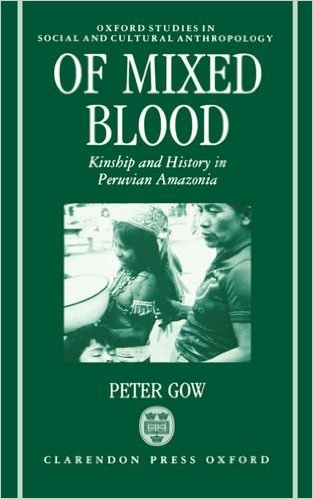
Of Mixed Blood is an
ethnography of the native people of the Bajo Urubamba river in Peruvian Amazonia.
The people of this region appear very
acculturated when compared to better-known indigenous Amazonian peoples. Peter
Gow’s analysis focuses on features of social organization which would seem to
demonstrate this most clearly: the role of schools and recent land reform laws
in the definition of the community, and native people’s claim to be `of mixed
blood’.
By stressing that these claims are made by
native people themselves, he challenges the dominant vision of them as passive
victims of history. Dr Gow argues that when native people’s claims are viewed
from the perspective of their own values, and in the context of their creation
of life through the productive transformation of the forest and the commodity
economy, they can be seen to form a coherent part of kinship.
Historical change is thus revealed as interior
to the ongoing creation of kinship for native people, rather than alien to it.
This study offers a new approach to the issue of historical and ethnographic
analysis of Amazonian cultures.
GOW, P. 2001. An Amazonian Myth and Its History. Oxford: Oxford University Press.
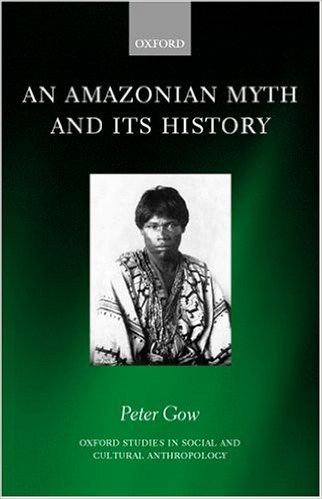
Taking as its starting point a single myth told to him by a Piro man, Peter Gow presents an analysis of a century of social transformation in an indigenous Amazonian society, the Piro people of Peruvian Amazonia. He unites the ethnographic data collected by the fieldwork methods invented by Malinowski with Levi-Strauss’s analyses of the relations between myth and time. Gow explores Piro history and ethnography outwards into the domains of myth-telling in general, and following the logic of certain important myths, extends his exploration further out into other important domains of Piro experience such as visual art, shamanry and girls’ initiation ritual. All these domains, like the myths themselves, have been demonstrably changing over the period since the 1880s. He goes on to show how these changes are in fact transformations of transformations, changes in social forms that are intrinsically about change. He traces the pattern of change through the historical circumstances of Piro people from the 1880s to the 1980s, to show how the inherently transformational nature of Piro social forms led them to respond as they did to the coming of rubber bosses, missionaries, and film-makers. This book makes an important contribution to debates in anthropology on the nature of history and social change, as well as addressing neglected areas such as myth, visual art, and the methodological issues involved in addressing fieldwork and archival data.
HARNER, M. (ed).1973. Hallucinogens and Shamanism. Oxford: Oxford University Press.
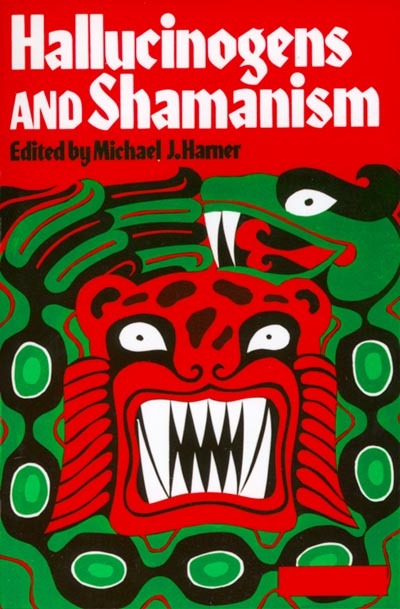
Anthropologists have
long been fascinated by the worldview and religious beliefs of primitive
peoples. Only recently, however, with the such of interest in hallucinogenic
agents in our own culture, have researchers begun to acknowledge the essential
role of such substances in the cosmology of many of these primitive societies.
In this unusual collection, ten original studies explore the use of
hallucinogens in shamanism: the ancient and widespread practice of invoking a
trance state to perceive and manipulate supernatural forces.
The research ranges from the aboriginal tribes of the Upper Amazon to cultures
undergoing Westernization, such as the Apaches of the Southwestern United
States; from the mythenshrouded cults of medieval witchcraft to a modern
laboratory experiment. The authors discuss the ritual use of ayahuasca (a potent tea made from the
jungle vine Banisteriopsis), psychotropic
mushrooms, peyote cactus, and the more esoteric solanaceous plants – mandrake,
henbane, and “deadly nichtshade.”
Unlike most earlier anthropological reports on shamanism these essays go beyond objective observation. Most of the authors have succeeded in penetrating the primitive mystical experiences by taking the psychotropic catalyst and participating in the native ceremonies. Almost uniformly, their fascinating accounts speak of the deep experience of another reality and profound duality of body and spirit. In this regard, Hallucinogen and Shamanism not only illuminates the thought patterns and religious views of many non-literate societies, but adds a new dimension to the psychology of religion.
HSU, E. & HARRIS, S. 2001. Plants, Health and Healing: On the Interface between Ethnobotany and Medical Anthropology. New York: Berghan Books.
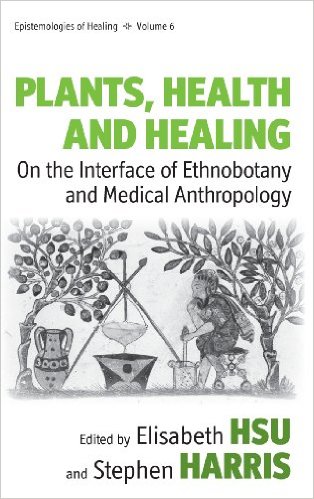
Plants have cultural histories, as their applications change over time and with place. Some plant species have affected human cultures in profound ways, such as the stimulants tea and coffee from the Old World, or coca and quinine from South America. Even though medicinal plants have always attracted considerable attention, there is surprisingly little research on the interface of ethnobotany and medical anthropology. This volume, which brings together (ethno-)botanists, medical anthropologists and a clinician, makes an important contribution towards filling this gap. It emphasises that plant knowledge arises situationally as an intrinsic part of social relationships, that herbs need to be enticed if not seduced by the healers who work with them, that herbal remedies are cultural artefacts, and that bioprospecting and medicinal plant discovery can be viewed as the epitome of a long history of borrowing, stealing and exchanging plants.
LABATE, B. & CAVNAR, C. 2013. The Therapeutic Use of Ayahuasca. Berlin: Springer-Verlag.
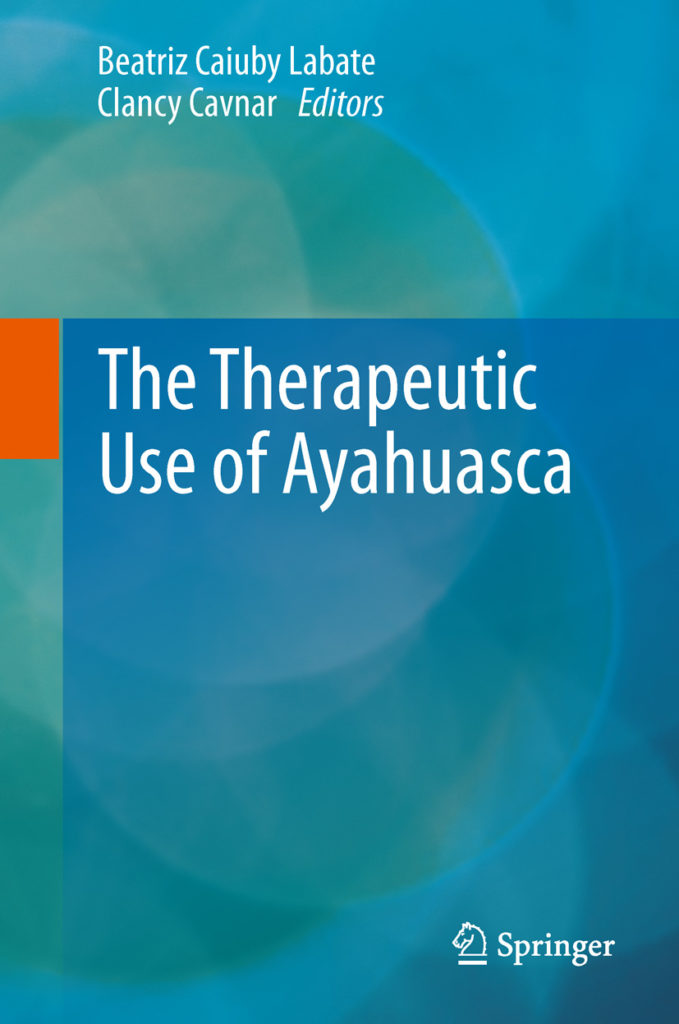
This book presents a series of perspectives on the therapeutic potential of the ritual and clinical use of the Amazonian hallucinogenic brew ayahuasca in the treatment and management of various diseases and ailments, especially its role in psychological well-being and substance dependence. Biomedical and anthropological data on the use of ayahuasca for treating depression, PTSD, and substance dependence in different settings, such as indigenous contexts, neo-shamanic rituals, contemporary therapeutic circles, and in ayahuasca religions, in both South and North America, are presented and critiqued. Though multiple anecdotal reports on the therapeutic use of ayahuasca exist, there has been no systematic and dense reflection on the topic thus far. The book brings the therapeutic use of ayahuasca to a new level of public examination and academic debate. The texts in this volume stimulate discussion on methodological, ethical, and political aspects of research and will enhance the development of this emergent field of studies.
LABATE, B.; CAVNAR, C. & GEARIN, A. 2017. The World Ayahuasca Diaspora: Reinventions and Controversies. Abingdon: Routledge.
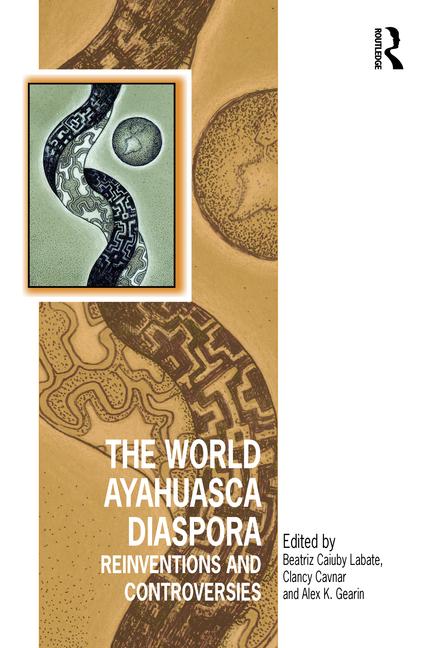
This book investigates how certain alternative global religious groups, shamanic tourism industries, and recreational drug milieus grounded in the consumption of the traditionally Amazonian psychoactive drink ayahuasca embody various challenges associated with modern societies. During its expansion from the Amazon jungle to Western societies, ayahuasca use has encountered different legal and cultural responses in the destination countries. This encounter is discussed in the book in terms of how it discloses contemporary controversies regarding religious ambivalence in modern societies, and how disparate and competing ontological and epistemological discourse on ayahuasca use has emerged among ayahuasca drinkers and between them and the state. The role of science in the confrontations between ayahuasca drinkers and the law is also contemplated. The chapters include ethnographic investigations of ritual practice, transnational religious ideology, the politics of healing, and the invention of tradition. Authors explore symbolic effects of a “bureaucratization of enchantment” in religious practice, and the “sanitizing” of indigenous rituals for tourist markets. Larger questions on the global economics of ayahuasca in terms of notions of commodification and the categories of sacred and profane are also addressed. This unique book explores classic and contemporary issues in social science and the humanities, providing rich material on the bourgeoning expansion of ayahuasca use around the globe.
LABATE, B. & HENRIK, J. (eds). 2011. The Internationalization of Ayahuasca. Berlin: Lit Verlag.
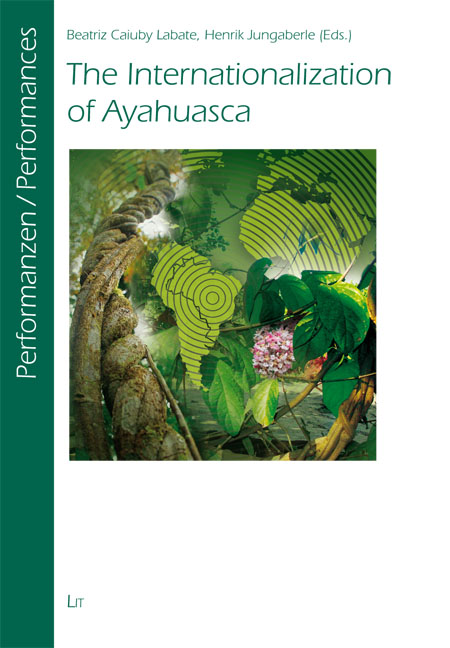
The Internationalization of Ayahuasca is composed of 27 articles (almost 500 pages) and is divided in three parts: “Ayahuasca in South America and the world”, “About medical, psychological and pharmacological Issues: is the use of ayahuasca safe?” and “The expansion of the use of Ayahuasca and the establishment of a global debate on ethics and legalization”. The book brings together the work of scholars from different countries and academic disciplines to offer a comprehensive view of the globalization of this Amazonian brew. It presents a rich array of reflections on the complex implications of this expansion, ranging from health, spiritual and human rights impacts on individuals, to legal and policy impacts on governments. As ayahuasca drinking becomes an increasingly established practice beyond the Amazon in the early 21st century, Labate and Jungaberle have put together a collection that is an unprecedented contribution to a growing field of research. It is a must-read for people interested in the present and future of ayahuasca, as well as in spirituality, ethnobotany, social science theory, contemporary religious and ritual studies, therapeutic potentials of psychedelics, and international drug policy. (Kenneth W. Tupper, Ph.D.)
LABATE, B. & BOUSO, J. (eds). 2013. Ayahuasca y Salud (Ayahuasca and Health). Barcelona: Los Libros de La Liebre de Marzo.
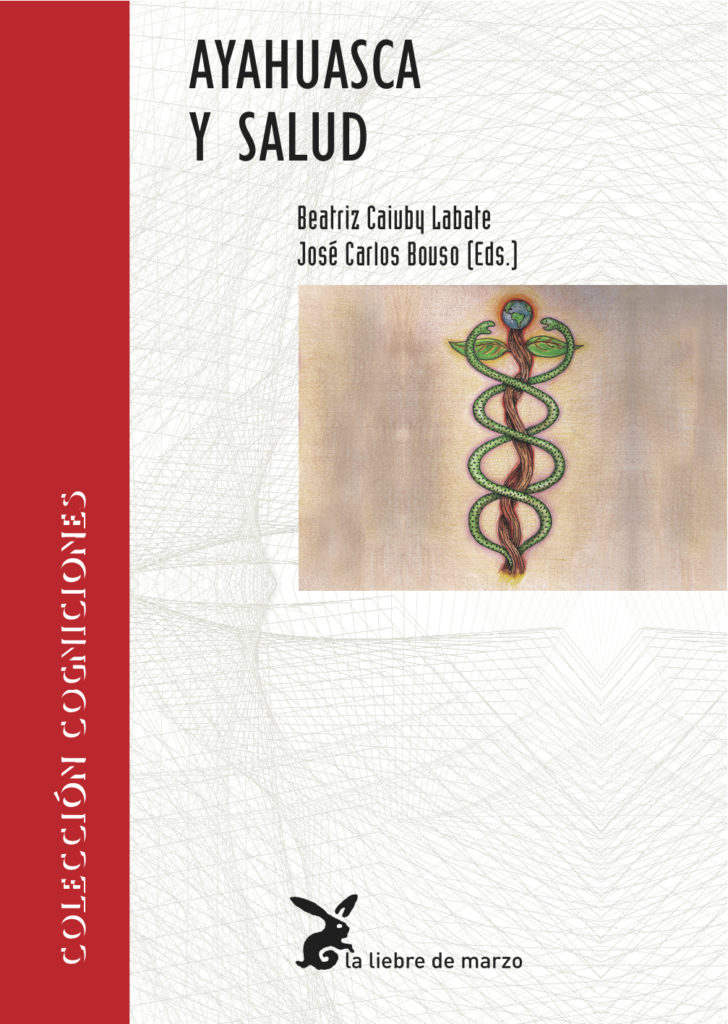
This collection brings together perspectives from the social and biomedical sciences as well as personal accounts of ayahuasca users in order to address diverse indigenous, mestizo and Western concepts of health, illness and curing related to the use of ayahuasca. Through a comparative analysis of the different contexts in which this psychoactive substance is consumed, this work investigates the boundaries between shamanism, religion and medicine while examining hybridization across the diverse knowledge-bases of ayahuasca practices. The diversity of cultural and regional situations is reflected in, for example, different traditions of governmental regulation of ayahuasca consumption: while Brazil permits religious (but not medicinal use) of ayahuasca, Peru has recently enshrined indigenous medical traditions surrounding ayahuasca as part of the national heritage. This work also presents some of the latest biomedical findings concerning the medical and therapeutic possibilities of ayahuasca. Numerous contributions highlight both agreements and disagreements between the “traditional” and the biomedical approach to health and health risks.
LABATE, B. & CAVNAR, C. 2014. Ayahuasca Shamanism in the Amazon and Beyond. New York: Oxford.
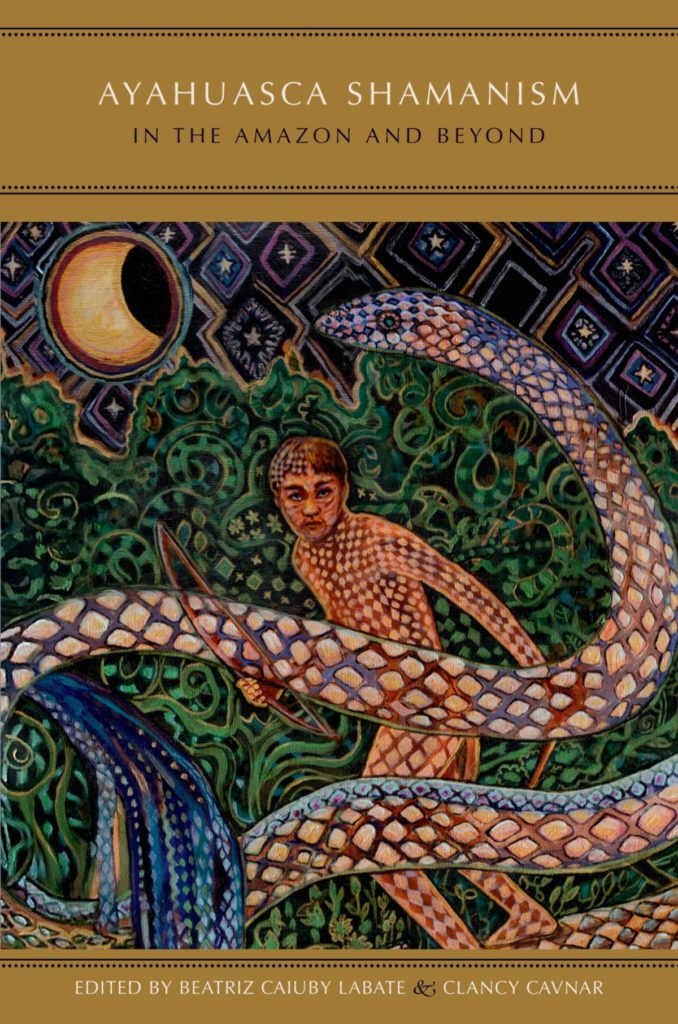
This book discusses how Amerindian epistemology and ontology related to certain indigenous shamanic rituals of the Amazon spread to Western societies, and how indigenous, mestizo, and cosmopolitan cultures have dialogued with and transformed these forest traditions. The collection also focuses on how shamanic rituals have been spreading and developing in post-traditional urban contexts throughout the world. Special attention is given to ayahuasca, a psychoactive drink usually composed of two plants, the vine Banisteriopsis caapi and leaves of the Psychotria viridis bush. Ayahuasca use has spread beyond its Amazonian origin and instigated a variety of legal and cultural responses in the countries it has spread to. The chapters in this book address some of the ways these responses have influenced ritual design and performance in traditional and non-traditional contexts. The book analyzes how displaced indigenous people and rubber tappers are engaged in creative reinvention of rituals, and how these rituals help build ethnic alliances and cultural and political strategies for their marginalized position. It also explores modernity’s fascination with “tradition” and the “other.” This phenomenon is directly tied to important classic and contemporary issues in anthropology. One of them is the relationship between the expansion of ecotourism and ethnic tourism, recent indigenous cultural revivals, and the emergence of new ethnic identities. Another focus of this book is on trends in the commodification of indigenous cultures in post-colonial contexts, and the combination of shamanism with a network of health and spiritually related services. Finally, the book addresses the topic of identity hybridization in global societies. The previously unpublished ethnographies and analysis collected in these chapters will add to the understanding of the role of ritual in mediating the encounter between indigenous traditions and modern societies.
LAMB, B. 1993. Wizard of the Upper Amazon. Berkeley: North Atlantic Books.
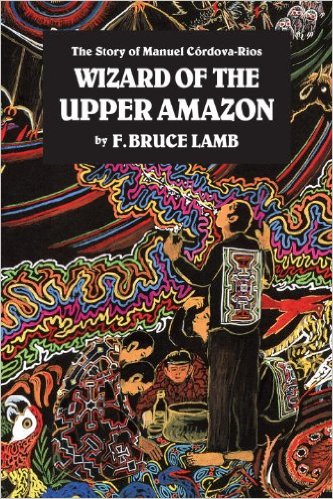
Wizard of the Upper Amazon is an extraordinary document of the life among a tribe of South American Indians at the beginning of the 20th century. For many readers, the most compelling sections of the book will be the descriptions of the use of Banisteriopsis caapi, the ayahuasca of the Amazon forests. This powerful hallucinogen has long been credited with the ability to transport human beings to realms of experience where telepathy and clairvoyance are commonplace. Manual Córdova, the narrator of these adventures is a well-known as a healer in Peru.
LUNA, L. & AMARINGO, Pablo. 1993. Ayahuasca Visions. The Religious Iconography of a Peruvian Shaman. Berkeley: North Atlantic Books.
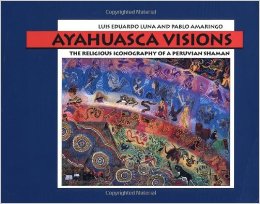
The mythologies and cosmology of Amazonian shamanism materialize in fantastic color and style in this unique, large-format volume, representing the fruit of several years of collaboration between a Peruvian folk artist/shaman and a Colombian anthropologist/filmmaker.
LUNA, L. & WHITE, S. 2016. Ayahuasca Reader: Encounters with the Amazon’s Sacred Vine. Santa Fe: Synergetic Press.
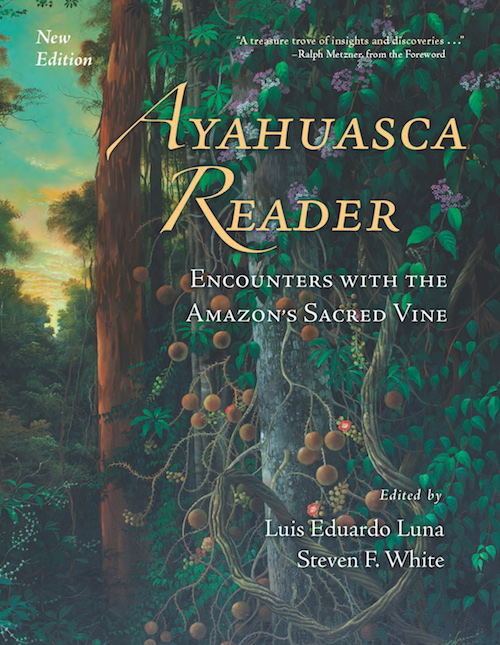
The AYAHUASCA READER is a four-part celebration of a sacred plant which grows in the Amazon rainforest and which, throughout the rainforest history, has been instrumental in allowing medicine men (and others) to leave their bodies behind and travel with their souls. Their experiences and the invaluable information they return with are so impressive that many anthropologists have felt the inclination to question them about these trips and the mythologies of their ancestors regarding them. Hence, part one of the AYAHUASCA READER consists of information divulged in such interviews. Part two consists of essays by (or about) the scientists themselves upon experiencing Ayahuasca in ceremonial settings. Part three discusses the use of Ayahuasca as a present day religious sacrament, and finally, in part four, well known celebrities from the literary world discuss their experience of Ayahuasca. All of this renders the AYAHUASCA READER the most comprehensive collection ever written on the subject, with essays translated from nearly a dozen languages. The many contributors include Françoise Barbira Freedman, Wade Davis, Philippe Descola, Allen Ginsberg, Jean Langdon, Peter Matthiessen, Dennis McKenna, W.S.Merwin, Richard Spruce, Gerardo Reichel-Dolmatoff, Mario Vargas Llosa, and more. As the myths within confirm, Ayahuasca has been a means of reconnecting with the invisible layers of the cosmos for millennia. Not surprisingly, the myths make for very fascinating reading in and of themselves, and certainly no study of world mythology is complete with them. The additional scientific, religious and literary points of view, then, are all wonderful bonuses. There is a lot at work here: As if the various stories from these disparate groups were not enough, there are depictions of the artwork of the indigenous peoples, photographs of a few of the Ayahuasca practitioners (including Ginsberg), a copy of a Brazilian watercolor depicting Ayahuasca, a copy of an oil painting depicting visions induced by the plant, and much more. From the religion section there are hymns a plenty, and from the literary section, as much eloquent prose and spirited poetry as a reader is likely to find in any literary anthology. Only a sacred vine (and perhaps a universal craving for a narcotic that promises at the end, you see God ) could so beautifully tie all these riches together.
METZNER, R. 1999. Ayahuasca: Human Consciousness and the Spirits of Nature. New York: Thunder’s Mouth.
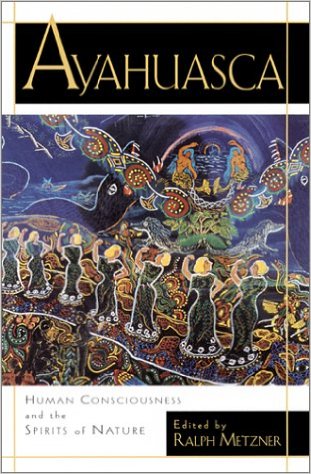
Ever since the “consciousness revolution” in the 1960s, dedicated spiritual seekers and scientific researchers from all continents have explored the world of psychoactive and hallucinogenic plants. In Ayahuasca, objective scientific information and the narratives of ayahuasca users — shamans and others — are presented together. Readers will also learn the pharmacology of this Amazonian plant.
METZNER, R. 2005. Sacred Vine of Spirits Ayahuasca. Rochester: Park Street Press.
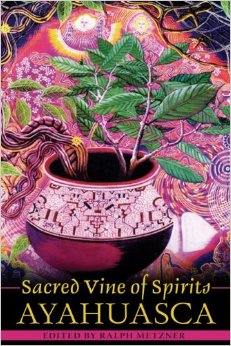
Ayahuasca is a
hallucinogenic Amazonian plant mixture that has been used for hundreds, perhaps
thousands, of years by native Indian and mestizo shamans in Peru, Colombia, and
Ecuador for healing and divination. Many Western-trained physicians and
psychologists have acknowledged that this substance can allow access to
spiritual dimensions of consciousness, even mystical experiences
indistinguishable from classic religious mysticism.
In Sacred
Vine of Spirits: Ayahuasca Ralph
Metzner, a pioneer in the study of consciousness, has assembled a group of
authoritative contributors who provide an exploration of the chemical,
biological, psychological, and experiential dimensions of ayahuasca. He begins
with more than 20 firsthand accounts from Westerners who have used ayahuasca
and then presents the history, psychology, and chemistry of ayahuasca from
leading scholars in the field of psychoactive research. He concludes with his
own findings on ayahuasca, including its applications in medicine and
psychology, and compares the worldview revealed by ayahuasca visions to that of
Western cultures.
NARBY, J. 1998. The Cosmic Serpent: DNA and the Origins of Knowledge. New York: Jeremy P. Tarcher/Putnam.
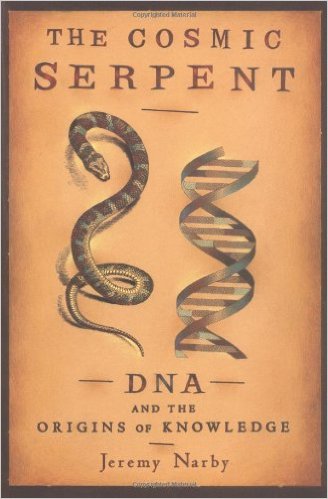
For ten years, Jeremy Narby explored the Amazonian rain forests, the libraries of Europe, and some of the world’s most arcane scientific journals, following strange clues, unsuppressible intuitions, and extraordinary coincidences. He collected evidence and researched the seemingly impossible possibility that specific knowledge might somehow be transferred through DNA, the genetic information at the heart of every cell of every living thing, to a specially prepared consciousness. Narby demonstrates that indigenous and ancient peoples have known for millennia – and have even drawn – the double helix structure, something Western science discovered only in 1953. He also suggests that DNA and the life it codes for at the cellular level are “minded.
OTT, J. 1994. Ayahuasca Analogues: Pangæan Entheogens. Kennewick: Natural Products Company.
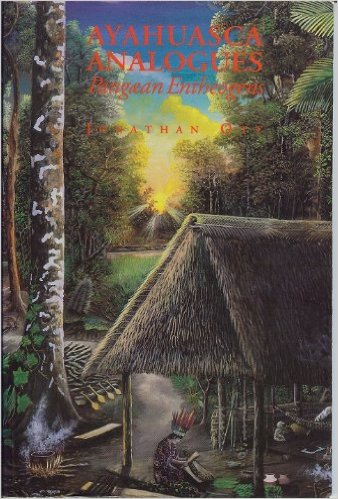
The main part of the book is divided into four chapters following an introductory-type Exordium: The Amazonian Amrta and the Entheogenic Reformation. The chapters cover a wide range of interesting material in a diverse disciplines: (1) Natural History of Ayahuasca-a Pan-Amazonian Entheogen; (2) Pharmacognosy of Ayahuasca Plants and Potions; (3) Ayahuasca Analogues with Psychonautic Reports; (4) From Pan Amazonian to Pan-Gaean Entheogen. There follow ten pages of highly useful notes and the Bibliography of 383 items. The complete, eightpage index provides easy access to the interdisciplinary information in this volume, much of which is difficult to find even in many of our large libraries. This first edition of Aywruasca Analogues consists of 5,000 copies, and it is this reviewer’s opinion that it will soon be unavailable in view of the inexpensive price of this most useful publication that will appeal to such an interdisciplinary audience.
REICHEL-DOLMATOFF, G. 1975. The Shaman and the Jaguar: A Study of Narcotic Drugs among the Indians of Colombia. Philadelphia: Temple University Press.
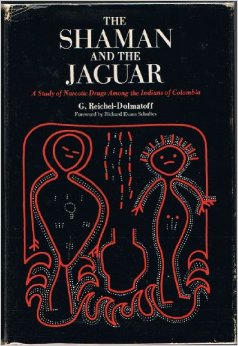
In the north-west Amazon region the natives make liberal use of hallucinogenic drugs in an effort to acquire powers of good or evil. In a detailed investigation of their religious experience, in which the transformation of the shaman into a jaguar is central, the author, an internationally-known ethnologist resident in Colombia, has collected his data from three sources: conversation with natives, their accounts being reproduced in translation, and in particular the services of a remarkable Indian who was able to analyse acutely his own people; the author’s personal experience when participating in drug-taking ceremonies; from a secondary source, the Spanish chronicles. The uniqueness of the book lies in Reichel-Dolmatoff’s intimate knowledge of these primitive peoples, and together with a thorough mastery of their language and customs he has been able to make close rapport with them, thus permitting him to penetrate their culture more effectively than anyone before him. A number of books of this kind have appeared recently, most of them attempting to understand the drug dependency of primitive peoples, and so, it is hoped, to assist in the comprehension and thus the handling of addiction in Western nations. Dr. Reichel-Dolmatoff, however, is interested primarily in the former and by studying it closely he is able to understand many basic cultural processes. His excellent book is, therefore, an outstanding contribution to social anthropology.
REICHEL-DOLMATOFF, G. 1997. Rainforest Shamans: Essays on the Tukano Indians of the Northwest Amazon. London: Themis Books.
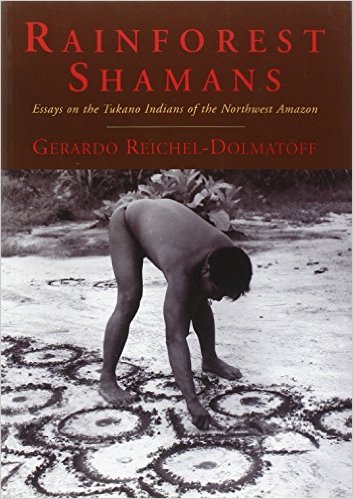
The renowned anthropologist Gerardo Reichel-Dolmatoff spent most of his working life among tribes living in the vast rainforests of the Colombian Northwest Amazon. This book brings together eleven of his essays and articles about the Tukano Indians. Many of the essays are concerned with the role of shamanism in Tukanoan society:?initiation practices, the rock crystal (the shamans’ principal power tool), which provides the model for many aspects of the shamanistic world-view; and their curing spells, which show the Tukanoan concepts of illness and its cure. Other essays describe their concepts of universal energies and the ways they can be balanced, and the ecological dimensions of their world-view.
RUSSELL, A. & RAHMAN. E. 2015. The Master Plant: Tobacco in Lowland South America. London: Bloomsbury Academic.
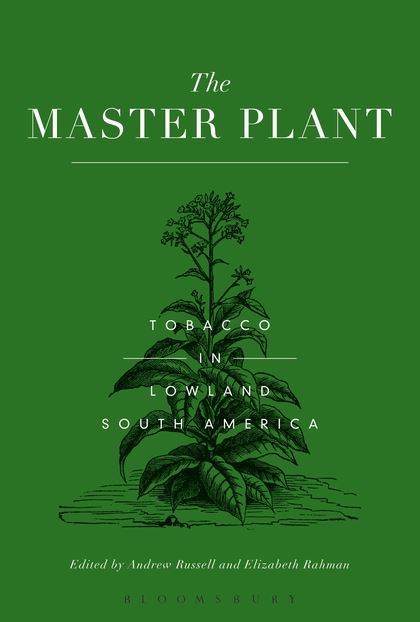
Described as a ‘master plant’ by many indigenous groups in lowland South America, tobacco is an essential part of shamanic ritual, as well as a source of everyday health, wellbeing and community. In sharp contrast to the condemnation of the tobacco industry and its place in contemporary public health discourse, the book considers tobacco in a more nuanced light, as an agent both of enlightenment and destruction.
Exploring the role of tobacco in the lives of indigenous peoples, The Master Plant offers an important and unique contribution to this field of study through its focus on lowland South America: the historical source region of this controversial plant, yet rarely discussed in recent scholarship. The ten chapters in this collection bring together ethnographic accounts, key developments in anthropological theory and emergent public health responses to indigenous tobacco use. Moving from a historical study of tobacco usage – covering the initial domestication of wild varieties and its value as a commodity in colonial times – to an examination of the transcendent properties of tobacco, and the magic, symbolism and healing properties associated with it, the authors present wide-ranging perspectives on the history and cultural significance of this important plant. The final part of the book examines the changing landscape of tobacco use in these communities today, set against the backdrop of the increasing power of the national and transnational tobacco industry.
The first critical overview of tobacco and its uses across lowland South America, this book encourages new ways of thinking about the problems of commercially exploited tobacco both within and beyond this source region.
SCHULTES, R. & HOFMANN, A. 1992. Plants of the Gods: Their Sacred, Healing, and Hallucinogenic Powers. Rochester: Healing Arts Press.

World-renowned
anthropologist and ethnopharmacologist Christian Ratsch provides the latest
scientific updates to this classic work on psychoactive flora by two eminent
researchers.
Numerous new and rare color photographs
complement the completely revised and updated text.
Explores the uses of hallucinogenic plants in
shamanic rituals throughout the world.
Cross-referenced by plant, illness, preparation,
season of collection, and chemical constituents.
Three scientific titans join forces to
completely revise the classic text on the ritual uses of psychoactive plants.
They provide a fascinating testimony of these “plants of the gods,”
tracing their uses throughout the world and their significance in shaping
culture and history. In the traditions of every culture, plants have been
highly valued for their nourishing, healing, and transformative properties. The
most powerful of those plants, which are known to transport the human mind into
other dimensions of consciousness, have always been regarded as sacred. The
authors detail the uses of hallucinogens in sacred shamanic rites while providing
lucid explanations of the biochemistry of these plants and the cultural
prayers, songs, and dances associated with them. The text is lavishly
illustrated with 400 rare photographs of plants, people, ceremonies, and art
related to the ritual use of the world’s sacred psychoactive flora.”
SCHULTES, R. & RAFFAUF, R. 1992. Vine of the Soul: Medicine Men, their Plants and Rituals in the Colombian Amazonia. Oracle: Synergetic Press.
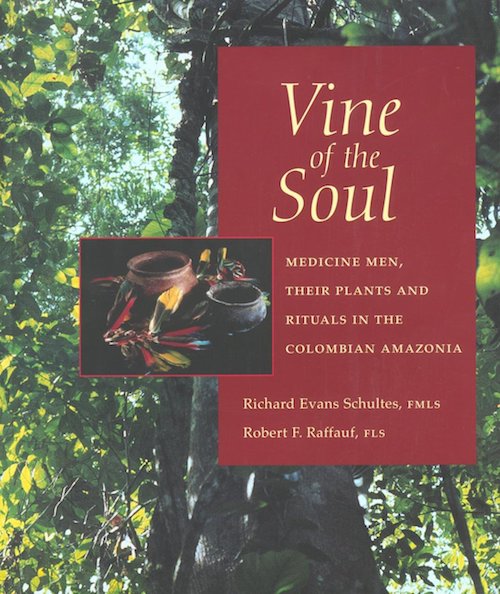
The most comprehensive collection of authoritative writings on the subject ever published. A panorama of texts translated from nearly a dozen languages on the ayahuasca experience. These include indigenous mythic narratives and testimonies, religious hymns, as well as narratives related by western travelers, scientists, and writers who have had contact with ayahuasa in different contexts. Some of the material in this Reader has been published before in difficult to find journals and books in a variety of languages.
SHANON, B. 2002. The Antipodes of the Mind: Charting the Phenomenology of the Ayahuasca Experience. Oxford: Oxford University Press.
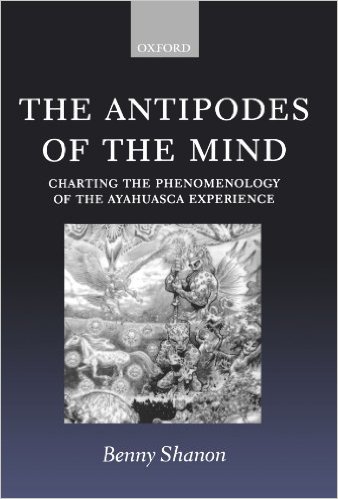
This is a pioneering cognitive psychological study of Ayahuasca, a plant-based Amazonian psychotropic brew. Benny Shanon presents a comprehensive charting of the various facets of the special state of mind induced by Ayahuasca, and analyzes them from a cognitive psychological perspective. He also presents some philosophical reflections. Empirically, the research presented in this book is based on the systematic recording of the author’s extensive experiences with the brew and on the interviewing of a large number of informants: indigenous people, shamans, members of different religious sects using Ayahuasca, and travellers. In addition to its being the most thorough study of the Ayahuasca experience to date, the book lays the theoretical foundations for the psychological study of non-ordinary states of consciousness in general.
TAUSSIG, M. 1986. Shamanism, Colonialism and the Wild Man: A Study in Terror and Healing. Chicago: University of Chicago Press.
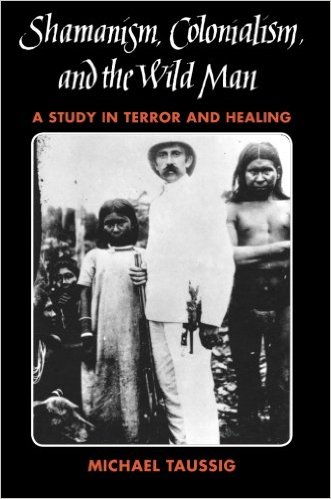
“Taussig has brought a formidable collection of data from arcane literary, journalistic, and biographical sources to bear on . . . questions of evil, torture, and politically institutionalized hatred and terror. His intent is laudable, and much of the book is brilliant, both in its discovery of how particular people perpetrated evil and others interpreted it.”—Stehen G. Bunker, Social Science Quarterly
WADE, D. 1996. One River: Explorations and Discoveries in the Amazon Rain Forest. New York: Simon & Schuste.
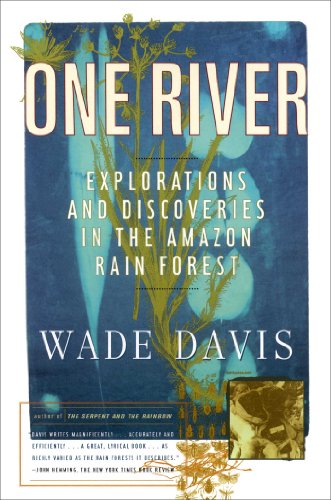
The story of two
generations of scientific explorers in South America—Richard Evans Schultes and
his protégé Wade Davis—an epic tale of adventure and a compelling work of
natural history.
In 1941, Professor Richard Evan Schultes took a
leave from Harvard and disappeared into the Amazon, where he spent the next
twelve years mapping uncharted rivers and living among dozens of Indian tribes.
In the 1970s, he sent two prize students, Tim Plowman and Wade Davis, to follow
in his footsteps and unveil the botanical secrets of coca, the notorious source
of cocaine, a sacred plant known to the Inca as the Divine Leaf of Immortality.
A stunning account of adventure and discovery,
betrayal and destruction, One
River is a story of two
generations of explorers drawn together by the transcendent knowledge of Indian
peoples, the visionary realms of the shaman, and the extraordinary plants that
sustain all life in a forest that once stood immense and inviolable.
WEISKOPF, J. 2002. Yajé, the New Purgatory: Encounters with Ayahuasca. Bogotá: Villegas Editores.
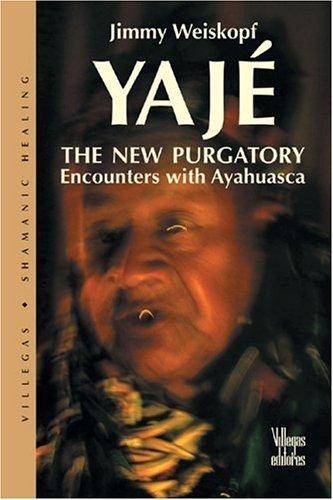
The unique path to both health and spiritual illumination offered by the consumption of yajé, a hallucinogenic herb embedded in the indigenous Amazonian cultures of Colombia, Brazil, and Peru, is thoroughly documented in this account of the culture and traditions that have developed around its use. The intensity of yajé-induced trances provoked the author to name them “the new purgatory” and resulted in this text’s respectful and hard-earned insights into indigenous ritual and shamanic guidance. A complete survey of yajé ceremonies; recent botanical and anthropological research on yajé; records of scientific and medical studies; its social, psychological, and ethical boundaries; and a look at past attempts to adapt the ancient ceremony to contemporary therapeutic and religious purposes are also provided.
WHITEHEAD, N. & WRIGHT, R. 2004. In Darkness and Secrecy: The Anthropology of Assault Sorcery and Witchcraft in Amazonia. Durham: Duke University Press Books.
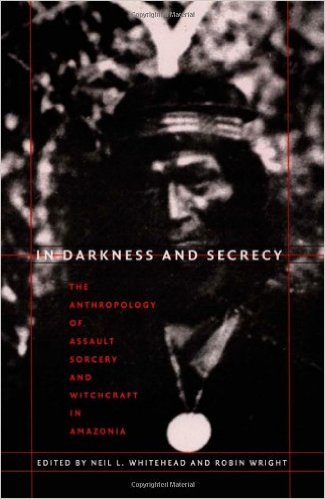
In Darkness and Secrecy brings together ethnographic examinations of Amazonian assault sorcery, witchcraft, and injurious magic, or “dark shamanism.” Anthropological reflections on South American shamanism have tended to emphasize shamans’ healing powers and positive influence. This collection challenges that assumption by showing that dark shamans are, in many Amazonian cultures, quite different from shamanic healers and prophets. Assault sorcery, in particular, involves violence resulting in physical harm or even death. While highlighting the distinctiveness of such practices, In Darkness and Secrecy reveals them as no less relevant to the continuation of culture and society than curing and prophecy. The contributors suggest that the persistence of dark shamanism can be understood as a form of engagement with modernity.
These essays, by leading anthropologists of South American shamanism, consider assault sorcery as it is practiced in parts of Brazil, Guyana, Venezuela, and Peru. They analyze the social and political dynamics of witchcraft and sorcery and their relation to cosmology, mythology, ritual, and other forms of symbolic violence and aggression in each society studied. They also discuss the relations of witchcraft and sorcery to interethnic contact and the ways that shamanic power may be co-opted by the state. In Darkness and Secrecy includes reflections on the ethical and practical implications of ethnographic investigation of violent cultural practices.
WHITTEN, N. 1976. Sacha Runa: Ethnicity and Adaptation of Ecuadorian Jungle Quichua. Urbana: University of Illinois Press.
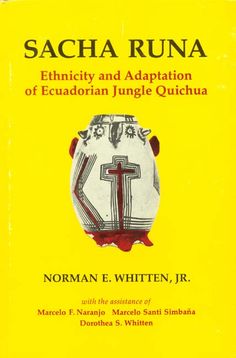
Norman Whitten’s book Sacha Runa: Ethnicity and Adaptation of Ecuadorian Jungle Quichua was published in 1976 by the University of Illinois Press. It was based on 18 months intensive participant-observation research in Amazonian Ecuador by Norman E. Whitten, Jr. and his late spouse, Dorothea Scott Whitten. It was the first full-scale ethnography of Amazonian Quichua-speaking indigenous people. Its focus was on both the enduring structures and adaptive versatility of these native South Americans who, at the time of the research, were facing cataclysmic change due to national attempts to obliterate their culture. Part 1 of the book portrays the lifeways of the Canelos Quichua as they existed at the time of the ethnography. Whitten sketches a biosphere of souls, spirits, and temporal, spatial, and color symbolism. Symbolism itself is treated in terms of economic, social, and political spheres with an emphasis on the integration of household, kinship, shamanism and ritual performances. Part 2 zooms down on the adaptive versatility of the rain-forest people to explain how their cultural-ecological resources help them maintain a meaningful existence in the face of national policies of modernization initiated by the foreign-sponsored oil boom. In the latter sections special focus is on the Puyo Runa peoples who move back and forth between urban and rural rain-forest settings. Significant in the entire portrayal is the ways by which shamanism pervades all aspects of rain-forest-Quichua life.
(As an aside, this book established the foundation for many other works, and Norman Whitten continues his work with the Canelos Quichua in 2017).
WILBERT, J. 1987. Tobacco and Shamanism in South America. Edited by R. Raffauf and Richard. Evan Schultes, Psychoactive Plants of the World Series. New Haven: Yale University Press.
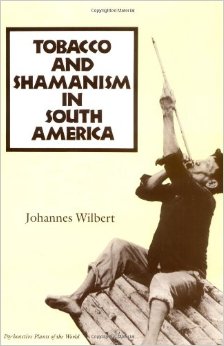
“This book is a comprehensive ethnographic survey of the uses of tobacco in nearly three hundred Indian societies in South America. This meticulously written book… is an awesome piece of scholarship which should be of interest not only to Wilbert’s fellow anthropologists but also to scholars in medicine, pharmacology, and history, especially ethnohistory.””-Virgil J. Vogel, Ethnohistory
Art by Karina Alvarez.
Take a minute to browse our stock:
Did you enjoy reading this article?
Please support Chacruna's work by donating to us. We are an independent organization and we offer free education and advocacy for psychedelic plant medicines. We are a team of dedicated volunteers!
Can you help Chacruna advance cultural understanding around these substances?









